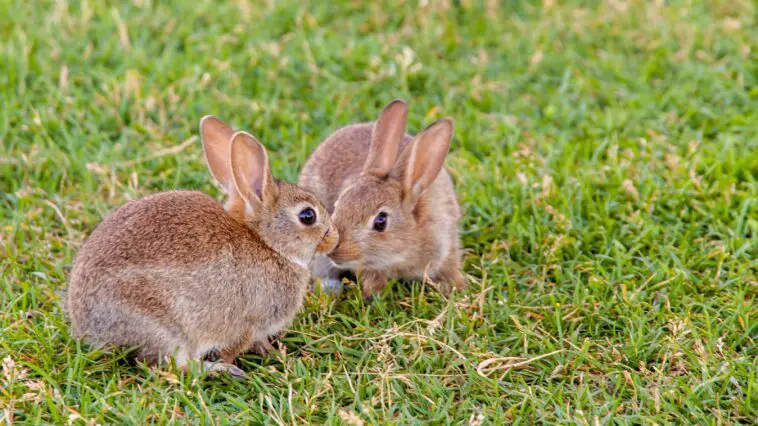Most pet owners decide to take care of rabbits because they are low maintenance, unlike dogs. However, they forget that they are more sensitive and need a lot of attention since they are more vulnerable to certain illnesses and diseases. They also have a unique diet that you need to consider to ensure their lifespan will improve.
Unlike the other health issues for rabbits, such as their eye and digestive function, the ear health of pet animals is often overlooked.
One problem that rabbit owners usually run into is ear mites. This problem can be considered as difficult to solve as ticks you can find under your dog’s hair because they are not visible to the naked eye of humans. According to Royal Veterinary College- University of London, ear infections are a common issue most rabbits encounter because of unwanted ear mite infestation.
If you are one of those pet owners struggling to get rid of mites in your rabbits, then keep reading this article.
Understanding Ear Mites
A mite is a small arthropod or psoroptes cuniculi. They are described as tiny mites that are usually less than 0.04 inches in length, and when they reach the ear of the rabbit, they grow their number by laying eggs, which is usually irritating for your pet. That is why rabbits infested with ear mites usually scratch their ears continuously.
Moreover, because of their small size, rabbit owners can easily mistake them for tiny specs of dirt inside their pet’s ear. But in actuality, this tiny mite that you originally mistook as dirt on your pets is actually feeding on your animals as parasites by consuming blood and the surfaces of their skin.
The National Library of Medicine reported that mites are considered parasites that infest rabbits and other pet animals. It can also cause several problems if left untreated. Although a few mites will not pose any significant threat to your rabbits. But once they have already colonized the inside of your rabbit ear and have grown to a number that is difficult to count, this will cause problems that may actually lead to long-term complications and other rabbit health issues.
To know more about Rabbit Health, Read This Article: Definitive Guide to Your Rabbit’s Health
Other common mites you will find on your rabbit are the Cheyletiella parasitovorax and Leporacarus gibbus. Like other parasites, these mites feed on the layer of your rabbit’s skin and cause several problems.
Life Cycle of Ear Mites
The life cycle for ear mites or P. cuniculi usually lasts 21 days. From laying eggs up to finding the potential host to grow their number.
Look at the table for the stages of the Ear Mites Lifecycle:
| Stages | Development Cycle |
|---|---|
| Stage One | Mites will find a host to lay eggs and grow their number. |
| Stage Two | After successfully finding the host, mites will lay their egg inside the ear or the skin’s surface. |
| Stage Three | The eggs will hatch and turn into larvae. The larvae are described to have six legs and begin to molt for the next four days inside the rabbit ear. |
| Stage Four | Then they will develop into mature eight-legged proto nymphs after 10 days. |
| Stage Five | Mature protonymphs will mate and grow their number, continue to infest, and repeat the cycle. |
Diagnosing Ear Mites
Parasitic Infestations are usually difficult to identify because of their small sizes. That is why the visual examination is not ideal when diagnosing ear mites. There is special equipment provided for medical doctors to be able to see on a bigger scale, even if the size of the parasite is relatively small.
Even if you think you can see the mites, there is a good chance you will simply dismiss them as speculations of dirt that your rabbit picked up that built up inside their ear after playing in a dusty part of their activity area.
However, if you use certain detection methods, you may be able to confirm the existence of mites on your rabbits. One tested method that doctors use is scraping. This includes using tape to remove a few mites from your rabbit and scrape off samples from the suspected part that has mites in your rabbit’s skin.
After scraping, the doctors will observe the skin sample under a microscope to see if the small specs of “dirt” from your rabbit are mites. After confirming, the doctor will provide medication to kill and stop a further infestation of ear mites in your rabbit pet.
Health Risk of Ear Mites
When mites begin to infest your rabbit’s ears, diseases that they get from the previously infected animal, like blood infection, can be transmitted to the new hosts. A colony of mites can easily cause itchy skin rashes.
In fact, mange or skin diseases in rabbits and other domesticated animals cause the Demodex mite, which lives on hair follicles and feeds on dead skin. Sometimes these mites actually live on our skin, but unlike our rabbits, they are generally harmless to humans when only a few exist. But you should still be wary because it causes skin diseases, even for humans.
As a rabbit owner, taking care of your rabbit is one priority you should take note of. If there is a parasitic infestation, visit your vet immediately to not further complicate the risks for your pet.
According to Hasting Veterinary Hospital, ear mite infestation should be taken seriously because it can be passed from rabbit to rabbit, especially if they are in the same household. Moreover, if they were to multiply rapidly on your rabbit, the ear mite would eventually cause problems and may even cause mange.
Here are the clinical signs that your rabbit is suffering from ear mite infestation:
- Excessive scratching in the ear
- Constant shaking of the head and ear
- Hair loss in the surround of the ear
- Sudden Weight Loss
- Loss of Appetite
- Foul Smelling Ear
- They make noises that they are in pain when you touch the rabbit’s ear
- Crusting and yeast are present inside and surrounding the ear
Prevention and Treatment of Ear Mites
Like other parasitic infestations, ear mites treatment is tough and requires a lot of patience, especially if the case is severe already.
Isolate the suspected rabbit from other pets
If you think your rabbit has ear mites because they show symptoms of infestation, you first need to isolate the other rabbit or pets nearby. This will help you and the household contain the mites from spreading and causing big risks in their life. Avoid them getting near the usual spot in their cage because there might be eggs and larvae from the mites growing in the area.
Disinfect and Clean the shelter area of the rabbit
One way to avoid further infestation of ear mites within the house is through disinfection and cleaning. It’s easier to do since there are available multi-purpose cleaners and pet parasite eliminators that can kill the eggs and adult mites attached to the surfaces of their cage.
You should also consider throwing away your rabbit’s bedding or anything it usually spends a lot of time on, like food and drinking bowls. The reason for doing all that is to keep your other pets safe and to get rid of anything that can be a breeding ground for more mites.
Put oil on the affected areas.
Do not remove the scabs caused by the mites on your rabbit. Instead, try to do a first-aid home remedy by putting oil like olive and coconut on the infected parts to keep the infection from further risks.
According to some reports, putting oil in rabbits’ ears, particularly olive, mineral, and coconut, is safe and can control mites by suffocating them under the oil. But take note that this is not a replacement for the actual treatment. Think of it as a remedy you can do before you take the rabbits to an actual expert.
Go and seek a veterinarian expert immediately.
The best practice in preventing or treating all related health problems for your rabbit is to seek expert advice from a veterinarian. They have the necessary equipment, such as a microscope, to diagnose whether your rabbit has an ear mite or other related rabbit parasite. Doctors will also know the severity of the infestation, and that is where they will depend on what type of medication they will give your rabbit.
Give your rabbit medication prescribed by the vet.
After taking the rabbit to the vet, the doctor will prescribe medicine you can use to eliminate the mites and other similar parasites. Your doctor will probably prescribe UltraCare or ProLabs as the medication you will be used to treat the mites on your rabbit. Repeat the treatment as necessary until the mites are gone. You can also check this video out if you want other ways of treating and getting rid of mites on your rabbits.
Key Takeaways
- Your rabbit pet can also get health problems with their ear. One common infestation is called ear mites or psoroptes cuniculi.
- Ear mites are described as small arthropods that live by sucking blood and eating the skin surfaces of their host that are 0.04 inches in length. Since their size is small, some rabbit owners mistake it as dirt inside their rabbit’s ears.
- Other common mites that will infest your rabbit ear are the Cheyletiella parasitovorax and Leporacarus gibbus. They also irritate your rabbit’s skin surface and cause long-term health complications if left untreated.
- Since the size of parasitic mites is not visible to the naked eye of humans, special equipment is needed to properly diagnose your rabbit with the infestation. This method is called scraping. The doctor will get a skin sample of the affected area of your pet, and they will put it under the microscope.
- Here are the common symptoms that you should keep an eye on if you suspect your rabbit with ear mites: Excessive scratching in the ear, shaking of the head and ear, hair loss, weight and appetite loss, foul smelling ear, making noises when you try to touch the ear, and crusting of the rabbit’s ear.
- Here are the things that you should do to prevent and provide treatment for your rabbit that has ear mites: isolate the other pet from the infected rabbit, disinfect the shelter and cage, put safe oil like olive and coconut to suffocate the mites, seek veterinarian advice, and provide the proper medication.
Related Content
Rabbit Diet
- The Definitive Guide To What Foods Rabbits Can & Cannot Eat
- 6 Rabbit Pellets You Can Trust
- Do Rabbits Love Sweet Foods? (Natural Treats & Feeding Guide)
- Best Treats To Reward Your Rabbits (Feeding Guide & Tips)
- What Food Do Baby Bunnies Eat? (Ideal Diet & Care Guide)
- How Long Can Rabbits Survive Without Food? (Survival Rate, Facts & Care Guide)
- What To Do When Your Rabbit Accidentally Eats Marijuana? (The Law, Signs, Treatment & Alternatives)
Rabbit Health
- Definitive Guide to Your Rabbit’s Health
- Diarrhea In Rabbits: Causes, Treatment & Prevention
- Understanding the Drinking Habit of a Rabbit
- Rabbit’s Digestive System: Parts, Problems, Treatment & Prevention
- Lumps In Rabbits (Causes, Types, & Treatment)
- Understanding Your Rabbit’s Eyes: Common Infections (And Treatment)
- Ear Mites in Rabbits: Diagnosing, Risks, Prevention & Treatment
- Parasitic Infestation: Encephalitozoon Cuniculi in Rabbits (What It Is, Symptoms & Treatment)
- Rabbit Testicles: Common Problems, Symptoms & Best Practices

